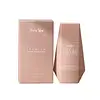What's inside
What's inside
 Key Ingredients
Key Ingredients

 Benefits
Benefits

 Concerns
Concerns

 Ingredients Side-by-side
Ingredients Side-by-side

Water
Skin ConditioningButylene Glycol
HumectantEthylhexyl Methoxycinnamate
UV AbsorberEthylhexyl Salicylate
UV AbsorberPhenylbenzimidazole Sulfonic Acid
UV AbsorberStearyl Alcohol
EmollientTriethanolamine
BufferingOctocrylene
UV AbsorberNiacinamide
SmoothingDiethylamino Hydroxybenzoyl Hexyl Benzoate
UV FilterHydroxyethyl Acrylate/Sodium Acryloyldimethyl Taurate Copolymer
Emulsion StabilisingButyl Methoxydibenzoylmethane
UV AbsorberSynthetic Fluorphlogopite
CI 77891
Cosmetic ColorantMica
Cosmetic ColorantPEG-100 Stearate
Hydrogenated Lecithin
EmulsifyingGlyceryl Stearate
EmollientBeeswax
Emulsion StabilisingCaprylyl Glycol
EmollientCarbomer
Emulsion StabilisingAdenosine
Skin ConditioningDisodium EDTA
Tin Oxide
AbrasiveCI 75470
Cosmetic ColorantThymus Vulgaris Leaf Extract
Skin ProtectingOriganum Majorana Leaf Extract
AntiseborrhoeicMentha Piperita Leaf Extract
Skin ConditioningRosa Canina Fruit Extract
AstringentParfum
MaskingWater, Butylene Glycol, Ethylhexyl Methoxycinnamate, Ethylhexyl Salicylate, Phenylbenzimidazole Sulfonic Acid, Stearyl Alcohol, Triethanolamine, Octocrylene, Niacinamide, Diethylamino Hydroxybenzoyl Hexyl Benzoate, Hydroxyethyl Acrylate/Sodium Acryloyldimethyl Taurate Copolymer, Butyl Methoxydibenzoylmethane, Synthetic Fluorphlogopite, CI 77891, Mica, PEG-100 Stearate, Hydrogenated Lecithin, Glyceryl Stearate, Beeswax, Caprylyl Glycol, Carbomer, Adenosine, Disodium EDTA, Tin Oxide, CI 75470, Thymus Vulgaris Leaf Extract, Origanum Majorana Leaf Extract, Mentha Piperita Leaf Extract, Rosa Canina Fruit Extract, Parfum
Water
Skin ConditioningIsododecane
EmollientPolysorbate 20
EmulsifyingButylene Glycol
HumectantSodium Acrylates/Beheneth-25 Methacrylate Crosspolymer
Skin ConditioningMethyl Methacrylate Crosspolymer
Hydrogenated Polydecene
EmollientLauryl Glucoside
CleansingDimethicone
EmollientTrimethylsiloxysilicate
EmollientEthylhexyl Methoxycinnamate
UV AbsorberTitanium Dioxide
Cosmetic ColorantTriethoxycaprylylsilane
PEG-20 Methyl Glucose Sesquistearate
EmulsifyingPolyhydroxystearic Acid
EmulsifyingNeopentyl Glycol Diethylhexanoate
EmollientPhenoxyethanol
PreservativeCI 77492
Cosmetic ColorantTriethanolamine
BufferingOctyldodecanol
EmollientEchium Plantagineum Seed Oil
Skin ConditioningHelianthus Annuus Seed Oil
EmollientCardiospermum Halicacabum Seed Extract
AntimicrobialCardiospermum Halicacabum Flower/Leaf/Vine Extract
Skin ConditioningNelumbo Nucifera Leaf Extract
Skin ConditioningAcrylates/C10-30 Alkyl Acrylate Crosspolymer
Emulsion StabilisingPEG-240
HumectantEthyl Ether
SolventSphingomonas Ferment Extract
Skin ConditioningDisodium EDTA
Water, Isododecane, Polysorbate 20, Butylene Glycol, Sodium Acrylates/Beheneth-25 Methacrylate Crosspolymer, Methyl Methacrylate Crosspolymer, Hydrogenated Polydecene, Lauryl Glucoside, Dimethicone, Trimethylsiloxysilicate, Ethylhexyl Methoxycinnamate, Titanium Dioxide, Triethoxycaprylylsilane, PEG-20 Methyl Glucose Sesquistearate, Polyhydroxystearic Acid, Neopentyl Glycol Diethylhexanoate, Phenoxyethanol, CI 77492, Triethanolamine, Octyldodecanol, Echium Plantagineum Seed Oil, Helianthus Annuus Seed Oil, Cardiospermum Halicacabum Seed Extract, Cardiospermum Halicacabum Flower/Leaf/Vine Extract, Nelumbo Nucifera Leaf Extract, Acrylates/C10-30 Alkyl Acrylate Crosspolymer, PEG-240, Ethyl Ether, Sphingomonas Ferment Extract, Disodium EDTA
Ingredients Explained
These ingredients are found in both products.
Ingredients higher up in an ingredient list are typically present in a larger amount.
Butylene Glycol (or BG) is used within cosmetic products for a few different reasons:
Overall, Butylene Glycol is a safe and well-rounded ingredient that works well with other ingredients.
Though this ingredient works well with most skin types, some people with sensitive skin may experience a reaction such as allergic rashes, closed comedones, or itchiness.
Learn more about Butylene GlycolDisodium EDTA plays a role in making products more stable by aiding other preservatives.
It is a chelating agent, meaning it neutralizes metal ions that may be found in a product.
Disodium EDTA is a salt of edetic acid and is found to be safe in cosmetic ingredients.
Learn more about Disodium EDTAEthylhexyl Methoxycinnamate is an organic compound that provides UVB protection. It often goes by the more common name of octinoxate. It is created from methoxycinnamic acid and 2-ethylhexanol.
Ethylhexyl Methoxycinnamate absorbs UVB rays with wavelengths between 280-320 nm. UV absorbers protect your skin by using chemical reactions to convert UV rays into heat and energy.
UVB (290-320 nm) rays emit more energy than UVA rays. They are capable of damaging DNA, causing sunburns and are thought to be linked to skin cancer.
The state of Hawaii has banned sunscreens containing octinoxate due to its potential impact on coral reefs. More research is needed to bridge gaps in this research. The European Union allows higher levels of octinoxate in sunscreens than the US and Australia.
Ethylhexyl Methoxycinnamate is oil soluble. It is not stable and may lose efficacy when exposed to sunlight.
Learn more about Ethylhexyl MethoxycinnamateTriethanolamine is an emulsifier and pH adjuster. It is created using ethylene oxide and ammonia. This gives Triethanolamine a nitrogen core and a similar scent to ammonia.
As an emulsifier, it prevents ingredients from separating and enhances texture by adding volume to a product.
PH adjusters are common in cosmetic products. The pH of a product can affect the effectiveness of other ingredients. A product with a high pH may also irritate the skin.
Learn more about TriethanolamineWater. It's the most common cosmetic ingredient of all. You'll usually see it at the top of ingredient lists, meaning that it makes up the largest part of the product.
So why is it so popular? Water most often acts as a solvent - this means that it helps dissolve other ingredients into the formulation.
You'll also recognize water as that liquid we all need to stay alive. If you see this, drink a glass of water. Stay hydrated!
Learn more about Water